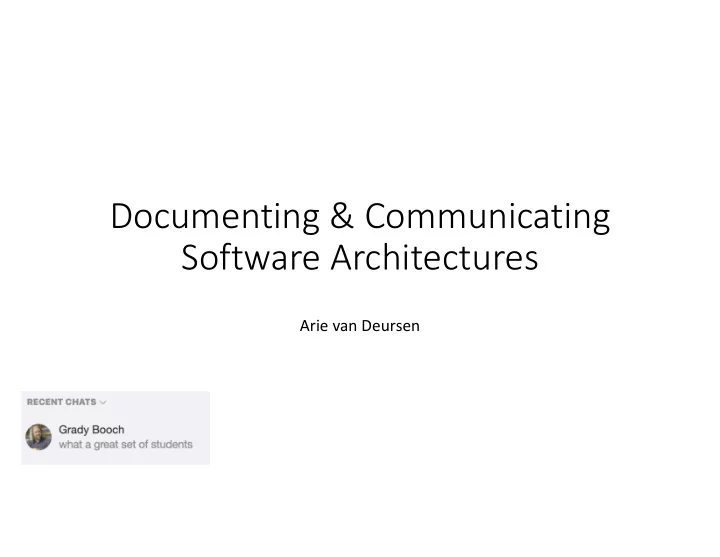

Documenting & Communicating Software Architectures Arie van Deursen
2
AOSA Example: Git 1. Git in a Nutshell Susan Potter 2. Git’s Origin 3. Version Control System Design 4. The Toolkit 5. The Repository 6. The Object Database 7. Storage 8. Merge Histories 9. What’s Next? 10. Lessons learned 3
4 Kruchten’s “4+1 Views” IEEE So'ware, November 1995
Architectural Views: Bones, Muscles, Nerves 5
6 Viewpoints Ch.3 • A collec'on of pa,erns, templates, and conven'ons for construc'ng one type of view. • Defines the • stakeholders whose concerns are reflected in the viewpoint • and the guidelines, principles, and template models for construc'ng its views.
A Viewpoint Taxonomy 7
Context View Ch.16 Describes the relationships, dependencies, and interactions between the system and its environment Environment: the people, systems, and external entities with which it interacts 8
11
Development View Ch.20 Describes the architecture that supports the so/ware development process. Communicates the aspects of the architecture of interest to stakeholders involved in building, tes<ng, maintaining, and enhancing the system. 12
Alternative Catalogs “View types”: • Module • Component & Connector • Alloca:on Component & connectors: • Pipe and filter, shared data, publish subscribe, client-server, p2p, … 16
Example: Pipes & Filter 17
ISO So&ware Quality Characteris5cs 18
21 Realizing Quality Attributes • An architecture must realize the required quality attributes • Models required that permit reasoning over quality attributes • Architectural decisions may have to make tradeoff between conflicting quality attributes
Architectural Perspectives Ch.4 An architectural perspective is a collection of architectural activities, tactics, and guidelines that are used to ensure that a system exhibits a particular set of related quality properties that require consideration across a number of the system’s architectural views. 2 2
Ch.4 23
The arc42.org Template for Architecture Communication and Documentation 1. Introduc+on and Goals 2. Constraints 3. Context and Scope
The arc42.org Template for Architecture Communication and Documentation 4. Solution strategy 5. Building block view 6. Run time view 7. Deployment view 8. Crosscutting concepts 9. Architectural decisions
The arc42.org Template for Architecture Communication and Documentation 10. Quality Requirements 11. Risks and Technical Debt
What Is Technical Debt? • Ward Cunningham: • “I coined the debt metaphor to explain the refactoring that we were doing.” hKp://c2.com/cgi/wiki?WardExplainsDebtMetaphor • Michael Feathers: • “The refactoring effort needed to add a feature non invasively” https://www.youtube.com/watch?v=7hL6g1aTGvo 33
Kruchten, 2013: The (missing) value of software architecture
Learning how to do it I am in favor of writing code to reflect your current understanding of a problem even if that understanding is partial 37 http://c2.com/cgi/wiki?WardExplainsDebtMetaphor
Assessing Technical Debt? • https://www.sonarqube.org/ • https://www.jarchitect.com/Metrics • https://github.com/tsantalis/JDeodorant
Beware: Debt is Relative • The refactoring effort needed to add a feature (resolve an issue) non invasively • Debt depends on features and issues to solve • Systems are used and society progresses • New libraries and versions come available • Actual usage affects our understanding of what matters • Debt quantifications / visualizations are only useful when they lead to action. Avoid ranting; propose rational action instead. 39
Microservices • Small, autonomous services that work together • Single Responsibility Principle: • Gather together those things that change for the same reason • Strong cohesion within the service • Loose coupling among services 40
41
The Role of the Architect The architect is responsible for designing, documenting, and leading the construction of a system that meets the needs of all its stakeholders. 44
Fred Brooks: Conceptual Integrity The quality of a system where all the concepts and their relationships with each other are applied in a consistent way throughout the system. Conceptual Integrity is the most important consideration in system design. It is better to have […] one set of design ideas, than [...] many good but independent and uncoordinated ideas. 45
How many Architects? Conceptual integrity in turn dictates that the design must proceed from one mind, or from a very small number of agreeing resonant minds 46
The Evolutionary Architect “architects need to shift their thinking away from creating the perfect end product, and instead focus on helping create a framework in which the right systems can emerge, and continue to grow as we learn more.” 47
Software Architect = Town Planner • Attempt to optimize the layout of a city • to best suit the needs of the citizens today, • taking into account future use • Cannot foresee everything that will happen. • Don’t plan for any eventuality, • Plan to allow for change 48
The Coding Architect? • Architects must ensure that systems are ‘habitable’ for developers too. • Architects must spend time with the team • Architects must spend time coding • Pair with a developer • Beyond code review • This should be a routine activity 49
Recommend
More recommend